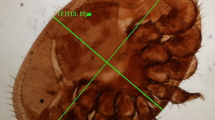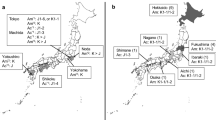Abstract
Varroa destructor is a major pest in world beekeeping. It was first detected in Madagascar in 2010 on the endemic honeybee Apis mellifera unicolor. To evaluate V. destructor spread dynamics in Madagascar a global survey was conducted in 2011–2012. A total of 695 colonies from 30 districts were inspected for the presence of mites. 2 years after its introduction, nine districts were found infested. Varroa destructor spread was relatively slow compared to other countries with a maximum progression of 40 km per year, the five newly infested districts being located next to the first infested ones. The incidence of mite infestation was also investigated by monitoring 73 colonies from five apiaries during 1 year (2011–2012). Sixty percent of local colony mortality was recorded after 1 year of survey. Varroa destructor strain determination was done by partial sequencing of the cytochrome oxidase I gene of 13 phoretic mites sampled in five districts. A single V. destructor mitochondrial haplotype was detected, the Korean type, also present in the closest African countries. A global pathogen survey was also conducted on the colonies inspected for mite presence. The greater wax moth, Galleria mellonella has been found in all colonies all over the country. Two other pathogens and morphological abnormalities in workers, such as deformed wings, were found associated with only V. destructor presence. A prevention management plan must be implemented to delimit mite spread across the island.



Similar content being viewed by others
References
Allsopp MH (1997) The honeybee parasitic mite Varroa jacobsoni. South Afr Bee J 69:73–82
Allsopp MH (2004) Cape honeybee (Apis mellifera capensis Eschscholtz) and varroa mite (Varroa destructor Anderson & Trueman) threats to honeybees and beekeeping in Africa. Int J Trop Insect Sci 24:87–94
Allsopp, M.H. (2006) Analysis of Varroa destructor infestation of southern African honeybee populations. Msc (Zoology), University of Pretoria
Anderson DL, Fuchs S (1998) Two genetically distinct populations of Varroa jacobsoni with contrasting reproductive abilities on Apis mellifera. J Apic Res 37:69–78
Anderson DL, Trueman JWH (2000) Varroa jacobsoni (Acari: Varroidae) is more than one species. Exp Appl Acarol 24:165–189
Boecking O, Genersch E (2008) Varroosis–the ongoing crisis in bee keeping. Zeitschrift für Verbraucherschutz und Lebensmittelsicherheit 3:221–228
Bowen Walker PL, Gunn A (2001) The effect of the ectoparasitic mite, Varroa destructor on adult worker honeybee (Apis mellifera) emergence weights, water, protein, carbohydrate, and lipid levels. Entomol Exp Appl 101:207–217
Calderon RA, van Veen JW, Sommeijer MJ, Sanchez LA (2010) Reproductive biology of Varroa destructor in Africanized honey bees (Apis mellifera). Exp Appl Acarol 50:281–297
Calderon RA, Urena S, van Veen JW (2012) Reproduction of Varroa destructor and offspring mortality in worker and drone brood cells of Africanized honey bees. Exp Appl Acarol 56:297–307
Charrière JD, Neumann P (2010) Surveys to estimate winter losses in Switzerland. J Apic Res 49:132–133
Delatte H, Virgilio M, Simiand C, Risterucci AM, DeMeyer M, Quilici S (2010) Isolation and characterization of microsatellite markers from Bactrocera cucurbitae (Coquillett). Mol Ecol Resour 10:576–579
Dietemann V, Pirk CWW, Crewe R (2009) Is there a need for conservation of honeybees in Africa? Apidologie 40:285–295. doi:10.1051/apido/2009013
Ellis A, Delaplane K (2009) Individual forager profits in Apis mellifera unaffected by a range of colony Varroa destructor densities. Insectes Soc 56:419–424
El-Niweiri MAA, El-Sarrag MS, Neumann P (2008) Filling the sudan gap: the northernmost natural distribution limit of small hive beetles. J Apic Res 47:183–184
Fazier M, Muli E, Conklin T, Schmehl D, Torto B, Frazier J, Tumlinson J, Evans JD, Raina S (2010) A scientific note on Varroa destructor found in East Africa; threat or opportunity? Apidologie 41:463–465
Franck P, Garnery L, Loiseau A, Oldroyd BP, Hepburn HR, Solignac M, Cornuet JM (2001) Genetic diversity of the honeybee in africa: microsatellite and mitochondrial data. Heredity 86:420–430
Ganzhorn JU, Lowry PP II, Schatz GE, Sommer S (2001) The biodiversity of Madagascar: one of the world’s hottest hotspots on its way out. Oryx 35:346–348
Genersch E (2010) Honey bee pathology: current threats to honey bees and beekeeping. Appl Microbiol Biotechnol 87:87–97
Guzmán-Novoa E, Eccles L, Calvete Y, Mcgowan J, Kelly PG, Correa-Benítez A (2010) Varroa destructor is the main culprit for the death and reduced populations of overwintered honey bee (Apis mellifera) colonies in Ontario, Canada. Apidologie 41:443–450
Kumar S, Nei M, Dudley J, Tamura K (2008) Mega: a biologist-centric software for evolutionary analysis of DNA and protein sequences. Brief Bioinform 9:299–306
Latreille PA (1804) Notice des espèces d’abeilles vivant en grande sociétée, ou d’abeilles proprement dites, et description d’espèces nouvelles. Ann Mus Natl Hist Nat 5:161–178
Le Conte Y, Ellis M, Ritter W (2010) Varroa mites and honey bee health: can Varroa explain part of the colony losses? Apidologie 41:353–363
Lindberg CM, Melathopoulos AP, Winston ML (2000) Laboratory evaluation of miticides to control Varroa jacobsoni (Acari: Varroidae), a honey bee (Hymenoptera: Apidae) parasite. J Econ Entomol 93:189–198
Lundie AE (1940) The small hive beetle. Aethina tumida, Science Bulletin Department of Agriculture and Forestry, Union of South Africa
Maggi M, Medici S, Quintana S, Ruffinengo S, Marcangeli J, Martinez PG, Fuselli S, Eguaras M (2012) Genetic structure of Varroa destructor populations infesting Apis mellifera colonies in Argentina. Exp Appl Acarol 56:309–318
Martin SJ, Highfield AC, Brettell L, Villalobos EM, Budge GE, Powell M, Nikaido S, Schroeder DC (2012) Global honey bee viral landscape altered by a parasitic mite. Science 336:1304–1306
Medina LM, Martin SJ (1999) A comparative study of varroa jacobsoni reproduction in worker cells of honey bees (Apis mellifera) in England and africanized bees in Yucatan, Mexico. Exp Appl Acarol 23:659–667
Navajas M, Anderson DL, de Guzman LI, Huang ZY, Clement J, Zhou T, Le Conte Y (2010) New Asian types of Varroa destructor: a potential new threat for world apiculture. Apidologie 41:181–193. doi:10.1051/apido/2009068
Ralalaharisoa-Ramamonjisoa, Z., H. Ralimananai, D. Lobreau-Callen (1996) Comportement de butinage d’Apis mellifera var unicolor (Hymenoptera, Apidae) dans divers biotopes. Biogéographie de Madagascar, 517–522
Ryba S, Titera D, Schodelbauerova-Traxmandlova I, Kindlmann P (2012) Prevalence of honeybee viruses in the Czech Republic and coinfections with other honeybee disease. Biologia 67:590–595
Sanford MT (1987) Diseases and pests of the honey bee. Institute of Food and Agricultural Sciences, University of Florida, Florida Cooperative Extension Service, pp 1–12
Solignac M, Cornuet JM, Vautrin D, Le Conte Y, Anderson D, Evans J, Cros-Arteil S, Navajas M (2005) The invasive Korea and Japan types of Varroa destructor, ectoparasitic mites of the western honeybee (Apis mellifera), are two partly isolated clones. Proc Royal Soc B: Biol Sci 272:411
Stern RA, Gazit S (1996) Lychee pollination by the honeybee. J Am Soc Hort 120:152–157
Thompson JD, Higgins DG, Gibson TJ (1994) Clustal W: improving the sensitivity of progressive multiple sequence alignment through sequence weighting, position-specific gap penalties and weight matrix choice. Nucleic Acids Res 22:4673–4680
Vieira GHD, Marchini LC (2009) Diversity of bees (Hymenoptera: Apoidea) in a cerrado area in the city of Cassilandia, Mato Grosso do Sul, Brazil. Sociobiology 53:597–607
Whitfield CW, Behura SK, Berlocher SH, Clark AG, Johnston JS, Sheppard WS, Smith DR, Suarez AV, Weaver D, Tsutsui ND (2006) Thrice out of Africa: ancient and recent expansions of the honey bee, Apis mellifera. Science 314:642–645
Yang X, Cox-Foster DL (2005) Impact of an ectoparasite on the immunity and pathology of an invertebrate: evidence for host immunosuppression and viral amplification. Proc Natl Acad Sci USA 102:7470
Acknowledgments
We thank Patrick Turpin for mapping sites with GIS and Christoph Simiand for technical help in the laboratory. We thank the following people for their help with data collection: Vincent Porphyre, Carlos Borsa, Valentina Mandirola, Niaina Andrianaivoariseta, Julien Cattel, Quentin Chesnais and ADEFA. We are grateful to the malagasy beekeepers who participated in the study. This work is part of the PhD of Henriette Rasolofoarivao recipient of a grant of CIRAD-AIRD-Sud. Field work had been partly funded by CIRAD, the Enlargement and sustainability of the Plant Protection Network (ePRPV) project supported by the European Union, the French government, and Réunion collectivities.
Author information
Authors and Affiliations
Corresponding author
Electronic supplementary material
Below is the link to the electronic supplementary material.
Rights and permissions
About this article
Cite this article
Rasolofoarivao, H., Clémencet, J., Ravaomanarivo, L.H.R. et al. Spread and strain determination of Varroa destructor (Acari: Varroidae) in Madagascar since its first report in 2010. Exp Appl Acarol 60, 521–530 (2013). https://doi.org/10.1007/s10493-013-9658-x
Received:
Accepted:
Published:
Issue Date:
DOI: https://doi.org/10.1007/s10493-013-9658-x




